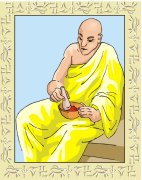
Worksheets and No Prep Teaching Resources
Reading Comprehension Worksheets
Ancient Mesopotamia

Ancient Mesopotamia
 Worksheets and No Prep Teaching Resources Reading Comprehension Worksheets Ancient Mesopotamia |
 Ancient Mesopotamia |
| edHelper's suggested reading level: | grades 5 to 7 | |
| Flesch-Kincaid grade level: | 6.76 |
|
Medicine in Mesopotamia
By Vickie Chao |

|
 1 In Greek, Mesopotamia (pronounced "mes-uh-puh-TAY-mee-uh") meant "the land between the rivers." Nestled between the Tigris and the Euphrates, this stretch of land was home to the world's oldest culture. (The bulk of it was in present-day Iraq.) As a matter of fact, because of its ancient status, Mesopotamia was often called the cradle of civilization.
1 In Greek, Mesopotamia (pronounced "mes-uh-puh-TAY-mee-uh") meant "the land between the rivers." Nestled between the Tigris and the Euphrates, this stretch of land was home to the world's oldest culture. (The bulk of it was in present-day Iraq.) As a matter of fact, because of its ancient status, Mesopotamia was often called the cradle of civilization. |
Create Weekly Reading Books
Prepare for an entire week at once! |
| Leave your feedback on Medicine in Mesopotamia (use this link if you found an error in the story) |
 |
Ancient Mesopotamia
|
 |
Social Studies
|